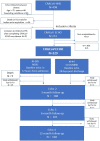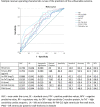Serial echocardiographic evaluation of COVID-19 patients without prior history of structural heart disease: a 1-year follow-up CRACoV-HHS study
- PMID: 37781311
- PMCID: PMC10533911
- DOI: 10.3389/fcvm.2023.1230669
Serial echocardiographic evaluation of COVID-19 patients without prior history of structural heart disease: a 1-year follow-up CRACoV-HHS study
Abstract
Background: It is a well-known fact that COVID-19 affects the cardiovascular system by exacerbating heart failure in patients with preexisting conditions. However, there is a poor insight into the cardiovascular involvement and sequelae in patients without preexisting conditions. The aim of the study is to analyse the influence of COVID-19 on cardiac performance in patients without prior history of structural heart disease. The study is part of the CRACoV project, which includes a prospective design and a 12-month follow-up period.
Material and methods: The study included 229 patients hospitalised with a diagnosis of COVID-19 (median age of 59 years, 81 were women). A standard clinical assessment and laboratory tests were performed in all participants. An extended echocardiographic image acquisition was performed at baseline and at a 3-, 6-, and 12-month follow-up. All analyses were performed off-line. A series of echocardiographic parameters was compared using repeated measures or Friedman analysis of variance.
Results: In all subjects, the left ventricular (LV) ejection fraction at baseline was preserved [63.0%; Q1:Q3 (60.0-66.0)]. Elevated levels of high-sensitivity cardiac troponin T were detected in 21.3% of the patients, and elevated NT-proBNP levels were detected in 55.8%. At the 1-year follow-up, no significant changes were observed in the LV diameter and volume (LV 48.0 ± 5.2 vs. 47.8 ± 4.8 mm, p = 0.08), while a significant improvement of the parameters in the biventricular strain was observed (LV -19.1 ± 3.3% vs. -19.7 ± 2.5%, p = 0.01, and right ventricular -19.9 ± 4.5% vs. -23.2 ± 4.9%, p = 0.002). In addition, a decrease in the LV wall thickness was also observed (interventricular septum 10.4 ± 1.6 vs. 9.7 ± 2.0 mm, p < 0.001; LV posterior wall 9.8 ± 1.4 vs. 9.1 ± 1.5 mm, p < 0.001).
Conclusions: In an acute phase of COVID-19, the elevation of cardiac biomarkers in patients with normal left ventricular ejection fraction is a frequent occurrence; however, it does not translate into clinically significant cardiac dysfunction after 1 year. The serial echocardiographic evaluations conducted in patients without preexisting structural heart disease demonstrate an overall trend towards an improved cardiac function and a reduced myocardial thickening at 1-year follow-up. This suggests that the acute cardiac consequences of COVID-19 are associated with systemic inflammation and haemodynamic stress in patients without preexisting conditions.
Keywords: COVID-19; NT-proBNP; SARS-CoV2; echocardiography; myocardial oedema; troponin.
© 2023 Olszanecka, Wojciechowska, Bednarek, Kusak, Wizner, Terlecki, Stolarz-Skrzypek, Klocek, Drożdż, Sładek, Bociąga-Jasik, Garlicki, Rewiuk, Matyja, Małecki, Sydor, Krzanowski, Grodzicki and Rajzer.
Conflict of interest statement
The authors declare that the research was conducted in the absence of any commercial or financial relationships that could be construed as a potential conflict of interest.
Figures
References
LinkOut - more resources
Full Text Sources
Research Materials
Miscellaneous



